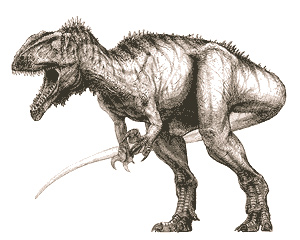New Sahara Dinos
Posted by: Loren Coleman on February 17th, 2008

Eocarcharia dinops
Fossil hunters have discovered two new meat-eating dinosaurs thanks to the fossils unearthed from the sands of the Sahara, according to media reports during the last week.
The fossils represent previously unknown ferocious dinosaur predators that roamed the Earth about 110 million years ago during the Cretaceous Period, University of Chicago paleontologist Paul Sereno and co-author Stephen Brusatte reported in the journal Acta Palaeontologica Polonica.

Kryptops palaios
They named one Kryptops palaios, or “old hidden face,” because of a horny covering over its face. The other was named Eocarcharia dinops, or “fierce-eyed dawn shark,” for its razor-sharp teeth and bony brow.

Both were about 24 feet (8 meters) in length — and on the prowl for meat. Researchers believed Kryptops was a scavenger and had a uniform series of relatively pointy teeth and a short snout, whereas Eocarcharia was definitely a sabotage attacker, waiting for an opportunity to jump at something.
The two creatures lived at a time when land bridges connected Africa to India and even Antarctica, which was then a temperate home to dinosaurs. But Africa later became isolated and its dinosaurs followed unique evolutionary paths scientists have just begun to uncover.
“This is an important slice in geological time, and we don’t yet fully comprehend how dinosaurs on the southern continents were evolving then,” said Peter Makovicky, curator of dinosaurs at the Field Museum, who was not part of the Chicago team.
(Sourced from various news services.)
About Loren Coleman
Loren Coleman is one of the world’s leading cryptozoologists, some say “the” leading living cryptozoologist. Certainly, he is acknowledged as the current living American researcher and writer who has most popularized cryptozoology in the late 20th and early 21st centuries.
Starting his fieldwork and investigations in 1960, after traveling and trekking extensively in pursuit of cryptozoological mysteries, Coleman began writing to share his experiences in 1969. An honorary member of Ivan T. Sanderson’s Society for the Investigation of the Unexplained in the 1970s, Coleman has been bestowed with similar honorary memberships of the North Idaho College Cryptozoology Club in 1983, and in subsequent years, that of the British Columbia Scientific Cryptozoology Club, CryptoSafari International, and other international organizations. He was also a Life Member and Benefactor of the International Society of Cryptozoology (now-defunct).
Loren Coleman’s daily blog, as a member of the Cryptomundo Team, served as an ongoing avenue of communication for the ever-growing body of cryptozoo news from 2005 through 2013. He returned as an infrequent contributor beginning Halloween week of 2015.
Coleman is the founder in 2003, and current director of the International Cryptozoology Museum in Portland, Maine.










The Museum of Natural History shoud have a Dinosaur Diorama hall featuring life size models of Dinosaurs instead of Bones.
Fascinating find. We have no where near a complete fossil record of all life that has ever inhabited this world, and when these sorts of finds are made I see it as just a little more light shed on our Earth’s natural history, another step towards our understanding of the diversity of the life. I predict that as techniques become more advanced and new areas are searched, we are going to see some stunning fossil discoveries in the not so distant future.
Dinosaurs are always fascinating, at least to me.
I can’t wait for them to start searching more in Antartica. Have often wondered just what is below all that ice.
My favorite subject. Great news. With the horned covering over the skull of Kryptops makes me wonder if this type of Dinosaur had feathers. Paleontologists say that T-Rex young had feathers because of some recent fossil findings. More and more fossils, of the two legged meat eating species, are being found with having feathers. Like mystery_man, I think with advancement in technology there will be some great findings ahead. What I would give to be able to see what these fascinating creatures looked and sounded like. Thanks Loren for another good informational post. These are great additions to the Cretaceous Period.
Cool. I’m not a pro in this field by any means, but I have wondered recently for the purpose of the little arms and big head tail and fat legs on this basic, classic tyrannosaurus/allosaurus template.
I think that once the prey animal was subdued that they used the leverage of there tail and back legs to pull backwards and rip meat off the bone.
They could probably run fast like an ostrich too, and maybe snap there heads forward, catch a bite and then rip the prey backwards.
Just speculating.
Thanks Cryptomundo.
Hey Bob, maybe instead of dioramas they could use some of that cool hologram technology the Japanese recently used to promote the movie ‘The Water Horse’.
Wouldn’t that be cool? 🙂